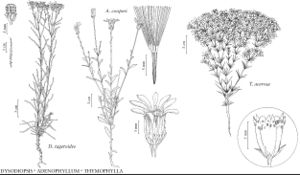Thymophylla
Gen. Sp. Pl., 25. 1816.
Annuals, perennials, subshrubs, or shrubs, (1–) 5–30 cm. Stems erect to spreading or decumbent, branched from bases or ± throughout. Leaves cauline; opposite or alternate; petiolate or sessile; blades often pinnately lobed, blades or lobes spatulate to linear or filiform, ultimate margins entire or toothed, faces glabrous or arachnose, canescent, floccose, lanate, puberulent, or tomentose (bases little, if at all, bristly-ciliate, oil-glands scattered in laminae or submarginal). Heads usually radiate, sometimes discoid or radiant, borne singly. Calyculi 0 or of 1–8 deltate to linear bractlets (bearing oil-glands). Involucres campanulate to obconic, 2–7 mm diam. Phyllaries persistent, 8–13 (–22) in ± 2 series (strongly connate 2/3–7/8+ their lengths, seldom with outer margins distinct more than 1/2 their lengths, exceptions: T. aurea, T. pentachaeta var. belenidium), usually bearing oil-glands. Receptacles convex, smooth or ± pitted, epaleate. Ray-florets usually 5, 8, 13, or 21, pistillate, fertile; corollas usually yellow to orange, rarely white. Disc-florets 16–100+, bisexual, fertile; corollas yellow to orange, tubes shorter than ± cylindric throats, lobes 5, deltate. Cypselae obpyramidal, obconic, or cylindro-clavate, glabrous or sparsely strigillose; pappi persistent, coroniform or of 10 (–20) distinct scales (each scale erose, or 1–5-aristate, or a fascicle of 5–9 basally connate bristles). x = 8.
Distribution
sw United States, Mexico, in West Indies, South America, Asia, Africa
Discussion
Species 13 (8 in the flora).
Selected References
Lower Taxa
Key
| 1 | Leaf blades not lobed (margins entire, toothed, or distally 3-fid); calyculi: lengths of bractlets usually 1/2+ phyllaries | > 2 |
| 1 | Leaf blades usually lobed (lobes 3–15+, linear to filiform, blades linear, usually entire in T. tenuiloba var. wrightii); calyculi 0, or lengths of bractlets less than 1/2 phyllaries | > 4 |
| 2 | Plants green, usually puberulent, sometimes glabrescent, rarely glabrous; leaves mostly opposite | Thymophylla acerosa |
| 2 | Plants ashy white, arachnose, lanate, floccose, or tomentose; leaves mostly alternate | > 3 |
| 3 | Stems spreading, often prostrate; leaf blades spatulate | Thymophylla micropoides |
| 3 | Stems erect; leaf blades linear to filiform, sometimes distally 3-fid | Thymophylla tephroleuca |
| 4 | Perennials or subshrubs (sometimes flowering first year); leaves mostly opposite | > 5 |
| 4 | Annuals (rarely persisting); leaves mostly alternate (sometimes opposite at 1–3 proximal nodes) | > 6 |
| 5 | Plants green, usually puberulent to canescent, sometimes glabrescent or glabrous; calyculi 0 or of 1–5 deltate bractlets | Thymophylla pentachaeta |
| 5 | Plants ashy white, tomentose; calyculi of 1–3 subulate bractlets | Thymophylla setifolia |
| 6 | Calyculi of 3–8 bractlets; disc florets 50–100+ | Thymophylla tenuiloba |
| 6 | Calyculi 0, or of 1–2 bractlets; disc florets 25–45 | > 7 |
| 7 | Margins of outer phyllaries distinct nearly to bases | Thymophylla aurea |
| 7 | Margins of outer phyllaries distinct less than 1/2+ their lengths | Thymophylla concinna |

